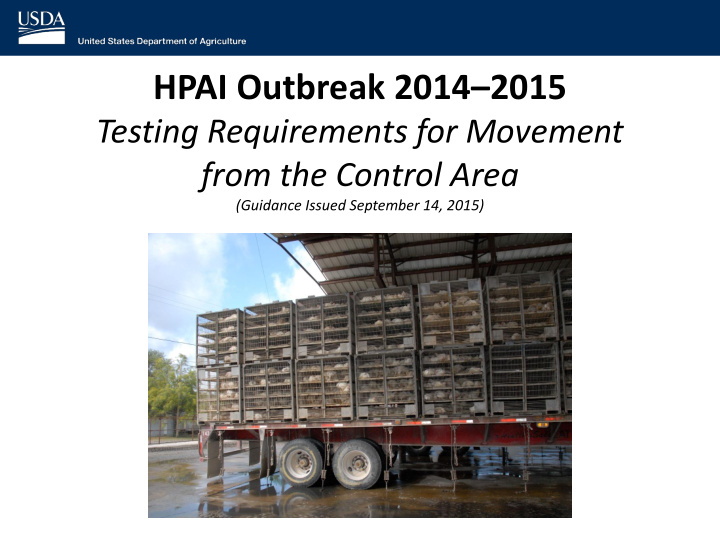



HPAI Outbreak 2014 – 2015 Testing Requirements for Movement from the Control Area (Guidance Issued September 14, 2015) 1
Policy Update Provides responders with revised procedures learned from the 2014 – 2015 highly pathogenic avian influenza HPAI outbreak. Key Components Overview Scope General Guidance for Interstate Movement Surveillance Guidance for Interstate Movement Holding Requirements for Egg Movement 2 2
Overview In a HPAI outbreak, continuity of business measures can help to move poultry and eggs from a Control Area while minimizing the risk of HPAI transmission. This document provides guidance on the requirements – particularly testing requirements — for moving poultry and eggs that originate from inside the Control Area. This includes movements out of or within an HPAI Control Area (Infected and Buffer Zones). 3
Scope There are other requirements for permitted and associated movement (e.g., biosecurity, cleaning and disinfection measures) in addition to the surveillance testing requirements given here. These requirements are further discussed in the Movement Control document and the Secure Food Supply Plans for Eggs, Broilers, and Turkeys. In the event that the poultry and eggs originating from inside the Control Area are destined for interstate movement, receiving States may have existing movement requirements. These requirements are not superseded or replaced by this guidance. This document incorporates recommendations for poultry and egg movement developed by the National Assembly of State Animal Health Officials (NASAHO) HPAI Permitting Working Group. 4 4
General Guidance for Interstate Movement 1. Movement of live poultry (including hatching eggs), should be evaluated rapidly based on the best information available: a. epidemiological investigation to rule out contact with Infected Premises, b. site-specific assessments, c. proactive risk assessments on movement-specific risk, and d. current surveillance information. In some situations after a new Control Area is established, States may opt to consider a delay in movement of live poultry (including hatching eggs) until the surveillance of commercial premises is completed. While sometimes this information may be rapidly obtained, in other circumstances obtaining complete surveillance information prior to movements is not feasible. Decisions on moving live poultry (including hatching eggs) should be based on the best science- and risk-based information available. 5 5
General Guidance for Interstate Movement 2. States should avoid placing additional restrictions on interstate movement of poultry and poultry products from outside of the Control Area in HPAI affected States. These recommendations do not supersede existing state regulations or requirements. 3. Traceability information is required for the premises of origin and premises of destination (each premises will need a Federal Premises Identification Number or the Emergency Management Response System (EMRS) will create a unique identifier). 4. The flock to be moved has normal flock production parameters as described in the Secure Food Supply Plans. 5. All movement should follow biosecurity procedures for Truck & Driver and Product Specific Biosecurity as described in the Secure Food Supply Plans. 6. The premises of origin is not an Infected, Suspect, or Contact Premises. a. The Incident Management Team (IMT) should determine the need for an epidemiology questionnaire if the flock has normal production parameters and negative tests. b. The receiving State may require information from the epidemiology questionnaire prior to granting permission to move. 6 6
Surveillance Guidance for Interstate Movement The NASAHO HPAI Permitting Working Group recommended the following surveillance sampling for the permitted movement of poultry and eggs out of or within an HPAI Control Area: 7. Testing of poultry should consist of a minimum of two 11-bird AI negative PCR pools per house. a. If there are fewer than 22 dead birds, all should be swabbed and the swabs should be divided into two pools (even if there are fewer than 11 dead birds). b. The sample size consists of one pool of 11 dead/sick birds per 50 dead birds per house. Frequency of sample collection: 1 c. i. Collect both pools within 24 hours prior to movement, or ii. Collect one pool within 48 hours prior to movement and the second pool within 24 hours prior to movement. 1 This guidance harmonizes existing Secure Food Supply Plan guidance, but provides an additional option for sampling for further 7 7 flexibility.
Holding Requirement for Egg Movement 8. Egg movement: a. Hatching eggs should follow the two-day holding procedure as described in the Secure Food Supply Plans and should use the recommended testing procedures (refer to #7). b. Table eggs (non-hatching eggs) should follow the two-day holding procedure as described in the Secure Food Supply Plans and the recommended testing procedures (refer to #7). 8 8
For More Information APHIS FAD PReP Website Movement Control Continuity of Business/Secure Food Supply Plans Secure Egg Supply Plan Secure Broiler Supply Plan Secure Turkey Supply Plan 9 11
Recommend
More recommend